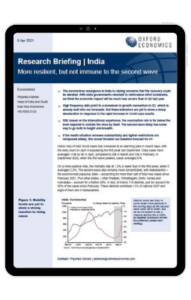India is more resilient, but not immune to the second wave

The coronavirus resurgence in India is raising concerns that the recovery could be derailed. With state governments reluctant to reintroduce strict lockdowns, we think the economic impact will be much less severe than in Q2 last year.
What you will learn from this report:
- High frequency data point to a slowdown in growth momentum in Q1, which is already built into our forecasts. But these indicators are yet to show a sharp deceleration in response to the rapid increase in Covid case counts.
- Still, based on the international experience, the vaccination rate is far below the level required to contain the virus by itself. The second wave likely has some way to go both in height and breadth.
- If the health situation worsens substantially and tighter restrictions are reimposed widely, this would threaten our baseline forecast for H1.
Tags:
Related Services

Post
UK: Supply constraints are probably less prominent in the south
The extent to which UK employers can respond to likely 2024 interest rate cuts with increased output, rather than rises in prices and wages, will partly reflect the extent of spare capacity. This will inevitably vary by region. Evidence on this is imperfect, but in terms of capital assets (including intangibles) and labour availability, southern regions appear to be in a stronger position than those in the UK's traditional industrial heartland.
Find Out More
Post
Global Private equity real estate fund maturities spur asset sales
We expect the significant increases in fund maturities, spurred by capital raised over the past decade, to exert upward pressure on the rate of asset disposals as the funds approach the end of their lifecycles.
Find Out More